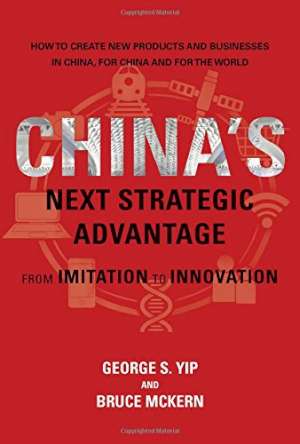28 June 2016
China’s Next Strategic Advantage: From Imitation to Innovation
George S Yip and Bruce McKern
2016, MIT Press, 304 pages,
ISBN 9780262034586
Reviewer: Sunil Krishnan, Head of Global Asset Allocation, Hermes Investment Management

It is twenty-seven years since publication of Ezra Vogel’s Japan as Number One: Lessons for America. For all its merits, that book is known best for its seemingly misplaced tone of inevitable ascent. It serves as a warning to writers aiming to predict national success on the basis of culture: it is not enough to showcase a few national winners. What is really unique about this culture, and is it better or just different?
Two business professors have taken up the same challenge for China, the 21st century’s contender for Number One. George Yip and Bruce McKern work both in China and the West, making them well placed to assess the former’s corporations in a global context. They argue that Chinese companies are poised to make innovation a competitive advantage over Western peers, and not just in the historic battlegrounds of the local market or lowest-cost production.
The authors argue that ‘four Cs’ define China’s corporate landscape and will drive China’s leadership: Customer, Culture, Capabilities and Cash. Their case is debatable. A customer base which is large, dynamic and demanding – even one which prompted white-goods giant Haier to develop a vegetable-rinse cycle for washing machines – fails to set large Chinese companies apart from Western firms with access to large free-trade zones. Culturally, China is surely home to some visionary business leaders and long-termist planners but this sounds uncannily similar to Vogel’s Japan. Capabilities for technical excellence and continuous innovation can be found within China’s most successful corporations, as can large pools of retained cash, but today these seem tautologies for any firm thriving anywhere in the post-2008 era.
Amid the volume of corporate interviews and case studies, though, some interesting features emerge. It is unusual for a centrally planned state to admit weaknesses publicly, let alone that, “Our country is not yet an economic power primarily because of our weak innovative capacity,” as the authors quote from a 2006 State Council strategy document. It is unusual for large markets, where even niche products can generate substantial revenues, to give up quality for mass customisation and lower cost without creating a reputational fuss. The authors discuss the runaway success of carmaker Chery, led by the fault-ridden QQ subcompact car, as an example of consumers’ willingness to ‘forgive and forget’. While the authors flirt with the Vogel trap, the book provides grounds to believe that Chinese businesses have some advantages in today’s fast-moving global markets, quite aside from any State support.
This is a business book, aimed at chiefs of the executive rather than economist kind. Corporate leaders who are already persuaded of the case to engage with China, but pondering how to achieve this, can access a range of suggestions and checklists in the second half of the book. Those looking for an appraisal of China’s macroeconomic outlook should look elsewhere, as might those who prefer a more critical assessment of corporates’ self-professed strategies and China’s commercial strengths.
But at a time when the dominant Western macro narrative views China’s model as productivity-destroying statism, and prone to brushing financial stability threats under a bulging carpet, firm-level studies of strategic thinking and creativity are a useful corrective. As Kerry Brown, author of a recent profile of Xi Jinping, recently commented, despite the immanence of the Party in China, “There are a number of spaces for people to do their own thing.”
